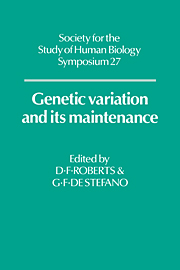Book contents
- Frontmatter
- Contents
- Preface
- Part I Genetic Diversity - Its Dimensions
- Genetic polymorphisms - a widening panorama
- Some implications of improved electrophoresis techniques for population genetics
- HLA variation in the tropics
- Chromosome polymorphism in humans
- Restriction fragment length polymorphisms in the human genome
- Nucleotide sequences, restriction maps, and human mitochondrial DNA diversity
- Mitochondrial DNA variation in eastern highlanders of Papua New Guinea
- The Contribution of polymorphisms in mtDNA to population genetic studies
- Part II Genetic Diversity - Its Origin and Maintenance
- GENETIC DIVERSITY - APPLICATIONS AND PROBLEMS OF COMPLEX CHARACTERS
- Index
Chromosome polymorphism in humans
Published online by Cambridge University Press: 05 March 2012
- Frontmatter
- Contents
- Preface
- Part I Genetic Diversity - Its Dimensions
- Genetic polymorphisms - a widening panorama
- Some implications of improved electrophoresis techniques for population genetics
- HLA variation in the tropics
- Chromosome polymorphism in humans
- Restriction fragment length polymorphisms in the human genome
- Nucleotide sequences, restriction maps, and human mitochondrial DNA diversity
- Mitochondrial DNA variation in eastern highlanders of Papua New Guinea
- The Contribution of polymorphisms in mtDNA to population genetic studies
- Part II Genetic Diversity - Its Origin and Maintenance
- GENETIC DIVERSITY - APPLICATIONS AND PROBLEMS OF COMPLEX CHARACTERS
- Index
Summary
INTRODUCTION
Human chromosomes exhibit structural variants which occur at considerable frequencies. Although at the Paris Conference on Standardization in Human Cytogenetics (1975) the term “chromosomal heteromorphism” was used for the description of these variants, the term “chromosomal polymorphism” is here used, “chromosomal” to indicate that the variant is at the level of microscopically detectable chromosome structures, “polymorphism” to indicate that it complies with the conventional definition of a genetic polymorphism.
Chromosomal polymorphic variants are constant within a given individual. At least, no consistent differences between the different cell types of one individual are known (though there are special problems with the nucleolar organizer regions, see below). Chromosomal polymorphisms are inherited in a simple Mendelian mode. They can be demonstrated by several techniques, but not all of them by any one technique. They are usually not present in an “all or none” fashion but show different grades, and this makes their evaluation rather difficult in some cases.
The chromosomal polymorphisms were reviewed a few years ago by Verma and Dosik (1980). They are of course also relevant clinically, e.g. as a contributing cause of chromosome abnormalities, as possibly associated with certain diseases, and with tumorgenesis (see, e.g., Atkin, 1977; Kivi & Mikelsaar, 1980; Sutherland, 1983; Glover et al, 1984). In this paper some considerations and new findings on the nature of the chromosomal polymorphisms are presented as well as a brief review of the more recent results of population studies.
TYPES OF POLYMORPHIC REGIONS OF CHROMOSOMES
Table 1 lists different types of chromosomal polymorphisms. The different chromosome bands are placed in one group because of their cytological and molecular similarities.
- Type
- Chapter
- Information
- Genetic Variation and its Maintenance , pp. 39 - 56Publisher: Cambridge University PressPrint publication year: 1986
- 1
- Cited by



